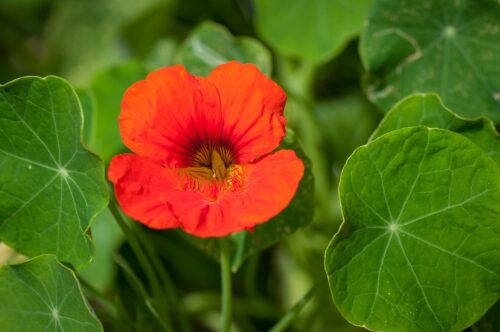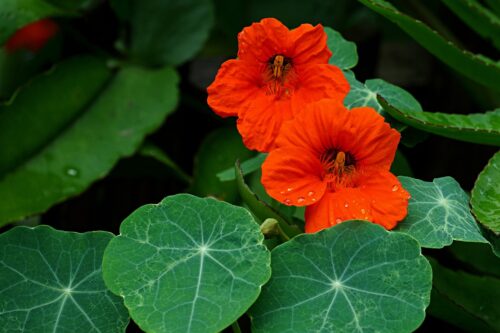Companion Planting with Nasturtium is a beneficial process that helps gardeners greatly by repelling nasty pests.
Companion Planting with Nasturtium offers a number of benefits. These beautiful flowers are not just eye-catching but also possess pest-repelling properties, making them great companion plants in the garden.
Read: Arugula Companion Plants
Nasturtiums

Nasturtiums (Tropaeolum majus) displays beautiful, bold, colorful blooms that range from warm yellows to fiery oranges and reds. They also serve multiple purposes in the garden. These annual plants are popular for their easy planting, versatility, companion planting, and ability to attract beneficial insects.
Companion Planting with Nasturtium (Benefits)
1. Pest Repellent Abilities
Nasturtiums act as natural pest repellents. The pungent aroma confuses and deters certain harmful insects like aphids, whiteflies, and squash bugs. Planting nasturtiums near susceptible crops can help protect them from these unwanted visitors. Companion planting with nasturtium also reduces the need for chemical pesticides.
2. Trap Cropping
Nasturtiums can work as trap crops. They distract pests away from more susceptible plants. In this way, they attract pests like aphids, drawing them away from your main crops. For better results, regularly inspect nasturtiums for pests and remove them manually.
3. Companion to Crops
Certain crops benefit from the presence of nasturtiums. For example, planting nasturtiums near cucumbers and squash can prevent cucumber beetles and squash bugs. They also work well with tomatoes and provide a natural deterrent against whiteflies and aphids.
4. Improve Soil Health
Nasturtiums have shallow roots that help improve soil structure. Their presence can prevent soil erosion, act as a living mulch, and reduce weed growth. When nasturtiums die back, they contribute organic matter to the soil and enrich it with nutrients for future plantings.
Read: Endive Companion Plants
How to Include Nasturtiums in Companion Planting
Placement
Strategically grow nasturtiums throughout your garden, especially near susceptible crops. Consider planting them as borders or intermingling them with other plants.
Container Planting
Growing Nasturtiums in containers makes them suitable for balcony or patio gardens. Pair them with herbs like basil or mint to create a colorful and functional container garden.
Interplanting
Plant nasturtiums between rows of vegetables or herbs. It will maximize their pest-repelling benefits and add a burst of color to your garden.
Good Companion Plants for Nasturtium
1. Tomatoes
Nasturtiums help deter aphids, which are common pests for tomatoes. They act as a protective barrier, reducing the chances of aphids damaging your tomato plants. Read about Tomato Companion Plants.
2. Cucumbers and Squash
These blooms are effective at repelling cucumber beetles and squash bugs, which are known to harm cucumber and squash plants. Planting nasturtiums nearby can help protect these crops naturally.
3. Radishes
The colorful blooms of Nasturtiums may help deter flea beetles, which can be a problem for radishes. By planting them together, you create a less inviting environment for these pesky beetles.
4. Herbs (like Rosemary, Mint, and Basil)
Nasturtiums can provide a colorful and protective border around herb gardens. Their presence helps repel certain pests and create a more pleasant environment for both herbs and nasturtiums.
5. Roses
You can protect roses from the attack of aphids by planting nasturtium nearby, especially the yellow ones.
6. Brassicas (Cabbage, Kale, broccoli)
Nasturtium attracts cabbage moths and saves the brassics like broccoli, kale, and cabbage.
7. Potatoes
The pretty flowers entice ladybugs, hoverflies, and parasitic wasps that assist in keeping hungry bugs away from potato leaves.
TIP: Use pesticides or insecticidal soap to repel aphids on nasturtiums as they protect your vegetables and other plants.
Read: Black Walnut Companion Plants
Bad Companion Plants for Nasturtium
Lavender, Rosemary, and Sage
These herbs prefer well-draining soil, while nasturtiums favor a bit more moisture. Planting them together might create an imbalance in water needs and impact the health of one or both plants.

